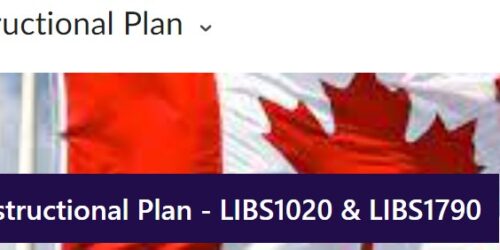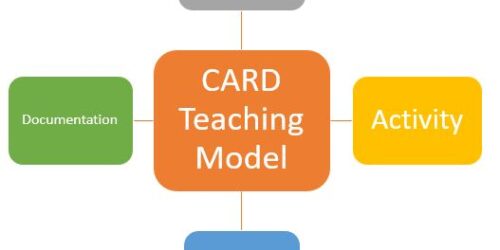
Content-Based Bridge-Ins
Many of you are likely already familiar with the BOPPPS framework for lesson planning. While BOPPPS is not the only way to plan a lesson in a post-secondary classroom, it has been around for more than 50 years and has proved itself to be a “fruitful, efficient, and effective instructional model that promotes students’ active participation in the classroom” (Zheng, 2023, p. 35). The very first step in a BOPPPS lesson plan is to “bridge-in” to the day’s content, and SoTL-related research consistently shows that content-based bridge-ins are an especially powerful and effective way to open each class (Hohensee, 2016; Roseguard & Wilson, 2013; Zheng, 2023). You’ll note that sometimes content-based bridge-ins also can serve as both bridge-ins and pre-assessments. That’s okay! The BOPPPS framework is malleable!
What are content-based bridge-ins? Why are they helpful?
Content-based bridge-ins are not general “get to know you” activities, or “tell me one fun thing that happened to you this past week” or “what is your favourite food” conversations. While those casual icebreaker questions and games have their time and place in the classroom and can sometimes help students feel welcome and appreciated, content-based bridge-ins are carefully thought out and planned in advance and align directly with one or more learning outcomes addressed in a particular lesson (Hohensee, 2016; Unruh & Petersen, 2009; Woodward, 2004).
Well-planned content-based bridge-ins serve many purposes:
- They can help students enter into “learning mode” and remind them right at the start of class what the central focus will be, and how it connects to previous weeks’ lessons.
- They are designed to help pique student interest and promote buy-in from the start–to remind students of the “why” of learning, and that they will be able to leave class a few hours later with a deeper understanding of and appreciation for the topics at hand.
- They can help with pacing as a well-constructed and clearly explained bridge-in can create a sense of urgency and excitement right from the start.
- They can help create a sense of classroom community as they often invite students to share knowledge and expertise, and offer an opportunity for faculty members to share stories and experiences from their own personal or professional lives.
- They can engage students in higher-order thinking right at the start of class and provoke compelling discussions.
- They can have a positive impact on attendance as a well-planned and skillfully executed lesson can serve as an incentive for students to come to class and arrive on time. If learners are encouraged to share ideas, opinions, and expertise with classmates throughout the lesson, and have an opportunity to discuss and debate key learning topics with others and their instructor, they’ll walk away from class understanding the “value add” of being present. They’ll understand why showing up to class matters and enhances their learning in ways that reviewing slides asynchronously on their own time can not. If students start to see that your lesson has a clear “arc” from bridge-in to summary, they may also feel more inclined to arrive on time so as not to miss the start.
Types of bridge-ins
There are countless types of content-based bridge-ins you can use. A general list will be provided here, and some specific examples expanded on below. When thinking up a content-based bridge-in activity, remember to always start with the specific unit outcome(s) you’ll be teaching to in your lesson for the day.
- A recent news clip or article. If something has surfaced in the news locally or globally that connects with your class unit learning outcome(s), sharing a short article on the topic or brief audio or video excerpt from the news could be an effective way to warm up the class. Not only does it reveal to students that what they are learning with you this semester is relevant and applicable to the “real world,” but it can also help build community and the teacher-student relationship as they’ll note that you think about them and their learning between classes week-to-week.
- Storytelling: We have been telling each other stories since the beginning of human history. Stories help us connect and empathize with one another, and allow us to learn lessons in compelling, and less didactic ways. (Cox, 2021). In class, you might want to bridge-in to a lesson by sharing a specific story you experienced working in industry, or a more personal story about something you went through that connects to the day’s learning outcomes. You can even share anecdotes told to you by a friend or others. The stories you share may serve as cautionary tales, or demonstrate to students that you engage in reflective practice about moments that have gone “right” or “wrong” in your career, or even remind students that the work world is full of nuance and issues they’ll encounter are rarely black or white. “What would you do in this situation?” type stories can encourage learners to dive into higher-order problem-solving or debates right away.
- A provocative quotation or question: For a quick but powerful bridge-in activity, you might open class with a short quote written on the board. Perhaps it’s a particularly powerful sentence from the textbook chapter they were assigned to read before class, or a quote from popular culture or a historical figure, or a “charged” question that relates to the day’s learning outcome.
- A menti-meter word cloud: Can help assess not only students’ cognitive knowledge, but also their affective responses to/ feelings about the day’s topics. Here is one example of how this bridge-in activity could be facilitated in an online synchronous Nursing course.
- A “what went wrong” image or scenario: You might consider opening class with an image or scripted scenario that’s not quite right and then ask students to identify what is amiss.
- Material culture: You may want to bring in an object of some sort for students to look at, touch or pass around before sharing with them why it’s relevant to the day’s discussion.
Specific examples from Conestoga courses
Recent news item: Let’s imagine you’re teaching HEAL8190, Health Care and Social Service Management, and one of your unit outcomes for the week is to “Examine the role of the Ontario Health Teams and how they relate to the local health care system.” You might say to your class at the start: “Today we’re going to be talking about Ontario Health Teams. Though you’ve encountered this in your pre-class readings, I’ll remind you that the government’s stated goal is to ‘ensure that every person in Ontario can have the support of an Ontario Health Team… (and) that everyone in Ontario can benefit from better coordinated, more integrated care.’ I also came upon this news story this week that I’d like to share with you. I’ll ask you to listen carefully to this 2 min audio clip and then let me know if you found anything surprising in this news report and what this says about the success or failure of the Ontario Health Team model.”
Material culture: Let’s imagine you’re teaching IENG8021, Packaging Testing Technology in the Structural Packaging and Design Management Program and in week 5, you are to teach the following two unit outcomes: (1) Identify various test methodologies of packaging performance in a distribution chain. (2) Perform industry-acknowledged testing to determine pass-fail acceptance. You might start class off by having 3 different types of packaged objects at the front of room (a steel drum, a jerrican, and a wooden box). You could ask for a few student volunteers to come to the front of class, stand on a chair, and take turns dropping these objects. As they do so, you could ask all students to look at Table 4 in their textbooks to help them answer a series of questions: “What angle should we drop this container at for its drop test? What sort of surface should we drop it on to? Why? How high should a wooden box be dropped from? Which parts of each container should we be especially concerned with examining after the drop test? Why?
You may also be interested in listening to this podcast interview with Ross Harwell who teaches in the Hearing Instrument Specialist Program about how and why he brings in props at the start of a particular class meeting each semester.
What went wrong? Let’s imagine you’re teaching CON8211, Construction Job Site Management in the Construction Job Site Management Program. This week’s unit is about meetings, negotiation, and dispute resolution and two key outcomes related to today’s lesson are: (1) Discuss the basic format that construction meetings follow and (2) Describe the different meetings, what they accomplish, and who should attend. You might consider creating in advance a short scripted dialogue, and invite a few students to the front of the room to take on different roles in the scenario. As it plays out, you can ask other students to note what is going wrong. (Perhaps in the scenario the construction manager clearly doesn’t have an agenda; timelines are unclear and characters are just saying “I’ll do this as soon as possible”. One person at the table might become overly aggressive when asked about something from last week’s meeting, it might become clear that no meeting minutes were ever taken for this project). Following students reading this 2-3 min scene that demonstrates what not to do, you could follow-up by asking the rest of the class: “Okay, what went wrong here? Which moment was particularly problematic? Why? What would you do differently if you were in this meeting?”
Storytelling. Let’s imagine you’re teaching LIBS1265 Your Life Through Story, and this week’s focus is on embodied storytelling and two related outcomes are: (1) Discuss how bodies and the ways they experience and understand the world differently intersect with discussions about perspective and (2) Practice experiencing and writing about the world through the senses. You might bridge-into class by asking students to focus in on their particular senses. Giving your own examples along the way. “Okay, we are going to have 5 mins for this activity as a warm-up to thinking about embodiment and perspective. I’ll invite you to write down one thing you hear right now… For example, I am sitting near a window and hear a woodpecker in the tree outside. Now, what’s one thing you feel? This might be a particular emotion, or something your body is touching. For example, I am going to write about this very itchy sweater I am wearing… I love the colour and it’s special to me because my grandmother knit it years ago, but it’s very uncomfortable to wear and itchy around the collar….” After guiding students through each sense for this activity, and strategically disclosing aspects of your own life and experience of the world, you might ask if anyone would like to share anything they wrote down and which entry point they would feel most inspired by to use to write a short story about their lives.
Introduce a Lesson Topic with an Image: Let’s imagine you’re teaching SCIE72000 Environmental Science, and this week’s lesson will introduce the topic of climate change that students will explore over several weeks. One related outcome is: “Discuss the range of environmental issues arising from overpopulation and human activity.” This is a topic that most students are well aware of and also may have related emotions tied to discussing the future of the climate. You may want to give space for students to recognize these emotions and thoughts before you start discussing this topic. An example of a bridge-in that might be used in this case is to show an image related to human activity and the environment, such as this photo of a landfill in Nairobi, Kenya by Edward Burtinsky, as part of the Anthropocene Project. You might then say something like: “To start today’s lesson, I’m sharing an image on the screen with you. Quietly, I would like you to look at this image and reflect on how it makes you feel or what comes to mind. What’s going on here? I will give you a few minutes to think, you are welcome to write down words that come to mind too, if you’d like, and then we will discuss as a class.” After a few minutes, bring the class back for a full group discussion. Ask students to share their thoughts and feelings about the image and tie their responses to the broader themes of the day’s lesson.
Another option for starting class with an image would be for students to work together to apply their knowledge and uncover some things that are amiss. For example, Let’s imagine you’re teaching OHS1420 Spa Health and Safety as part of the Esthetician program. Three of the learning outcomes for today’s class are: (1) Discuss health standards for practicing electrolysis, tattooing and dermal removals and (2) Explore current guidelines for suggested disposable items. (3) Discuss all possible repercussions of poor infection control. You might project onto the board an image of a spa that isn’t practicing appropriate health standards and ask students to work in small groups and note at least 5 things that are “wrong” with the spa set-up and also to discuss how these poor standards might lead to injury or infection.
Job Postings: Let’s imagine you’re teaching BUS8020, Organizational Behaviour, and today’s lesson is about leadership. Two specific learning outcomes are: (1) Compare and contrast leadership theories, and (2) Critically reflect on personal leadership styles and experience with leaders. You might decide to open class by sharing 2-3 current local job openings and say to students: ” I am going to open this week’s econestoga slides, and you’ll see I’ve added 3 current job postings. I will display them one by one and I will give you a minute to review each noting any words that tie to the OB topics we will be looking at today relating to leadership types and tactics. Once we have looked at all 3, turn to a partner and share (in-person) or pop in the chat (Zoom or Teams) what you noticed about what they are looking for.”
Related supports
More information about BOPPPS lesson planning in general can be found here, and those who are interested can also download a BOPPPS lesson planning template or join Teaching and Learning at our 3-day intensive Instructional Skills Workshop Course. Of course, you’re also always welcome to email teachingandlearning@conestogac.on.ca to set up a one-on-one meeting with one of our consultants to discuss specific details about your lessons and weekly content-based bridge-in options.
References
Cox, J. (2021). August 26. Storytelling in the Classroom as a Teaching Strategy. Teach Hub. https://www.teachhub.com/classroom-activities/2015/08/storytelling-in-the-classroom-as-a-teaching-strategy/
Ontario Health Teams. https://www.ontario.ca/page/ontario-health-teams
Hohensee, C. (2016). Teachers’ Awareness of the Relationship Between Prior Knowledge and New Learning. Journal for Research in Mathematics Education, 47(1), 17–27. https://doi.org/10.5951/jresematheduc.47.1.0017
Richards, J. C., & Rodgers, T. S. (2014). Approaches and methods in language teaching. Cambridge University Press.
Rosegard, E., & Wilson, J. (2013). Capturing Students’ Attention: An Empirical Study. Journal Of The Scholarship Of Teaching And Learning, 13(5), 1-20
Unruh, T., & Petersen, S. (2009). Guter Unterricht: Praxishandbuch: Handwerkszeug für Unterrichts-Profis (Alle Klassenstufen). AOL Verlag.
Woodward, T. (2004). Planning lessons and courses: Designing sequences of work for the language classroom. Cambridge University Press
Zheng, C. (2023) The BOPPPS instructional model: development and implications for secondary science instruction. Frontiers in Educational Research, 6(19). DOI: 10.25236/FER.2023.061907






